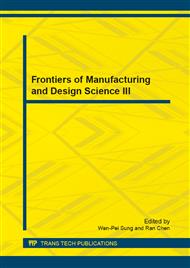p.333
p.338
p.343
p.347
p.353
p.357
p.362
p.367
p.372
Preliminary Study on Mechanism of Superalloy Deep-Hole Honing Technology
Abstract:
Anglicizing the superalloy mechanical and cutting characteristics, and according to the oil-stone grinding characteristics, choose the current commonly abrasives in the domestic. Processing performance test of inconel 718 deep-hole honing is carried out. The comparison test results show that the grinding performance of ceramic corundum is better than other oilstones at test condition. Grinding characteristics of ceramic corundum is carried on, study show that the size of ceramic alumina grits range from 0.067 to 0.005 μm, The grinding passivated tiny grains of ceramic corundum oil-stone broken and fall off timely, which is beneficial to oil-stones, self-sharpness. The excellent performance of ceramic corundumcan self-sharpening can improves the efficiency of honing effectively.
Info:
Periodical:
Pages:
353-356
Citation:
Online since:
December 2012
Keywords:
Price:
Сopyright:
© 2013 Trans Tech Publications Ltd. All Rights Reserved
Share:
Citation:


